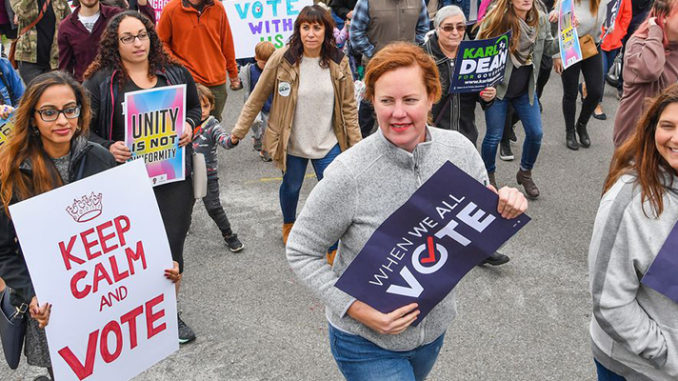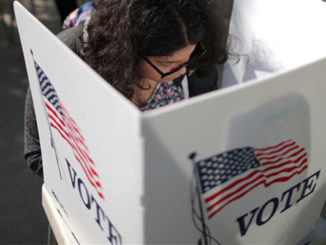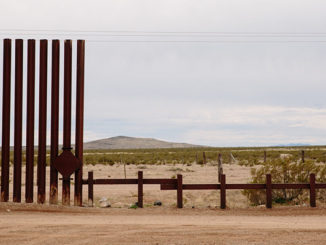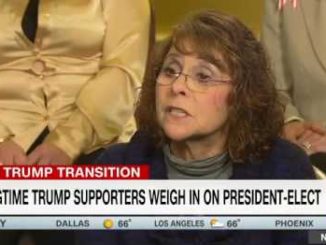
In four states, turnout was as high as 1 in 3
by Stephen Sawchuk
The kids are all right—or, at least, on a good trajectory where voting is concerned.
In data provided first to Education Week by the Center for Information & Research on Civic Learning and Engagement, many states showed higher-than-usual rates of teenage-voter turnout in the 2018 mid-term elections. One in three eligible 18- and 19-year-olds voted in Colorado, Minnesota, Montana, and Oregon. And in about half the states, the turnout for that age group broke the 1 in 5 mark. Nationwide, 23 percent of eligible teenagers voted.
CIRCLE, which is located at Tufts University, analyzed state voter files obtained through third-party vendors to arrive at the state-by-state estimates. There are no comparative data for this age group, but prior turnout rates for youth in general in midterms have hovered in the low teens, so these figures represent a substantial increase.
Still, teens’ voting participation was far from universal. In general, for U.S. youths, voting is a far less anticipated adult activity than taking their first spin behind the wheel of a car or their first sip of a (legal) beer.
“I’d love voting to be sort of like a rite of passage, like getting your driver’s license,” said Shawn Healy, the director of democracy initiatives at the Robert R. McCormick Foundation, a leader of civics education efforts in Illinois. “In this country, it means more to turn 16 than to turn 18.”
The data also provide the best look yet at voting habits of young people moving from high school to beyond. A majority of students receive their only formal civics education in high school, Education Week has previously reported.
Analyzing Patterns
But parsing the data for clues on what drove variations among teen voting in the states—and what educators can do to sustain that momentum—is tricky because of the number of factors that can influence voter-turnout rates.
More homogenous states with stronger levels of what sociologists call social capital—the norms and values that unite groups—often have higher turnout than states that are more diverse and represent many types of communities. (Think of the vast differences in Utah’s and New York’s populations, for example.)
Turnout rates are often influenced by the competitiveness of political races. Georgia historically has had low voting rates, but a fiercely competitive gubernatorial race there helped boost turnout in 2018. (Indeed, Georgia’s turnout rates for 18- and 19-year-old voters fell solidly in the middle of the pack.)
And states’ voting policies matter. The CIRCLE researchers found a modest correlation between online voter registration and turnout rates for 18- to 19-year olds, and also between voter pre-registration, which only about half of states allow, and those turnout rates. Some states’ laws directly impacted young people: Michigan required many first-time registrants to vote in person—on a school day.
The overall culture of civic participation in the state and—yes—formal civics education programs also likely had an impact.
Some highlights in the data: Minnesota, a state with generally high turnout in elections, topped the list for 18- to 19-year olds, with 37.1 percent voting. Much has been written about the state’s expansive policies, which include same-day voter registration.
Maryland’s and Massachusetts’ results provide a bit of a cautionary tale about lumping first-time voters in the same category as voters in their late 20s. Both states had a much smaller proportion of 18- and 19-year-old voters show up compared to the larger 18- to 29-year-old population, with gaps in turnout of 14 and 15 percentage points, respectively.
There’s no clear explanation why, though, at least from an educational standpoint. Maryland has had a longstanding service-learning requirement, while Massachusetts only recently passed new civics education laws.
In Florida, the epicenter of the March For Our Lives movement and the tidal wave of youth anti-gun-violence activism flowing from it, 29 percent of 18- to 19-year-olds voted, despite high rejection rates in Broward County of absentee ballots from people in this age category.
Despite a very active March For Our Lives presence in Chicago, Illinois had somewhat disappointing results: Just 14 percent of eligible teen voters turned out. The state had few competitive statewide races. (J.B. Pritzker won the governorship by nearly 16 percentage points.) On the other hand, Illinois is among the states that has invested in civics education for several years. (Its most recent requirement—a high school course mandate—was passed by the state legislature this summer.)
“The work we’re doing on civics education is a generational investment,” Healy said. “I would hope over time we would see higher turnout.”
Nevada is perhaps the most striking example of all. Eligible teenage voters turned out at 30.8 percent—more than 2 percentage points higher than the larger category of 18- to 29-year-olds (28.7 percent), the only state in the union to display that pattern. Something happened in Nevada to prompt high school-age students to vote at incredible rates, but the exact cause is unclear.
Two major school districts closed school on Election Day, probably helping boost turnout, and early voting was hugely popular, noted Marc Picker, the co-president of the Nevada Center for Civic Engagement. Civics teachers took full advantage, encouraging students to vote early.
But, he said, there’s still room for improvement in the state’s civics education efforts, especially in teacher training.
“The problem is there are a lot of districts and a lot of states who think civics education is just a term—give students a book and have them read out to the class about the Continental Congress,” Picker said. “That’s not enough. It doesn’t answer the question of why and what does that have to do with me in 2019.”
In fact, noted Alma D. Romo, the Nevada state coordinator for Mi Familia Vota, a group that helps register high school students to vote, the students she spoke to had two contemporary major issues that captured their interest: Student debt and immigration.
Studies also show that teaching students about the voting process makes it more likely that they’ll actually vote, noted Carolyn DeWitt, the president and executive director of Rock the Vote, a group that supports youth civic engagement. Those findings make it imperative that high schools cover voting registration and the voter process in their curricula.
“Young voters are new voters. They are unfamiliar with the process. They are insecure about their understanding of our political system and that makes them less confident participating and weighing in,” she said. “So civics education plays a huge role in empowering them.”
CIRCLE and other civics experts, meanwhile, point to the need for schools and communities to provide more “on ramps” to voting culture to sustain the momentum among teen voters. That will necessarily involve both schools and other public agencies, they said, since there is a plethora of out-of-school avenues for students to learn about the voting process before they can actually vote. Some states, for instance, permit youths to volunteer as poll workers.
Romo said her group is rethinking its model and considering having high school students help register their peers in other schools. “We want it to be so they have that leadership role,” she said.
Abby Kiesa, CIRCLE’s director of impact, agreed.
“There is considerable room for innovation and considerable opportunity to figure out how to make this work for any and every community,” she said.
Stephen Sawchuk is an associate editor for Education Week. His beat includes district leadership and management, school safety, and civics education.




